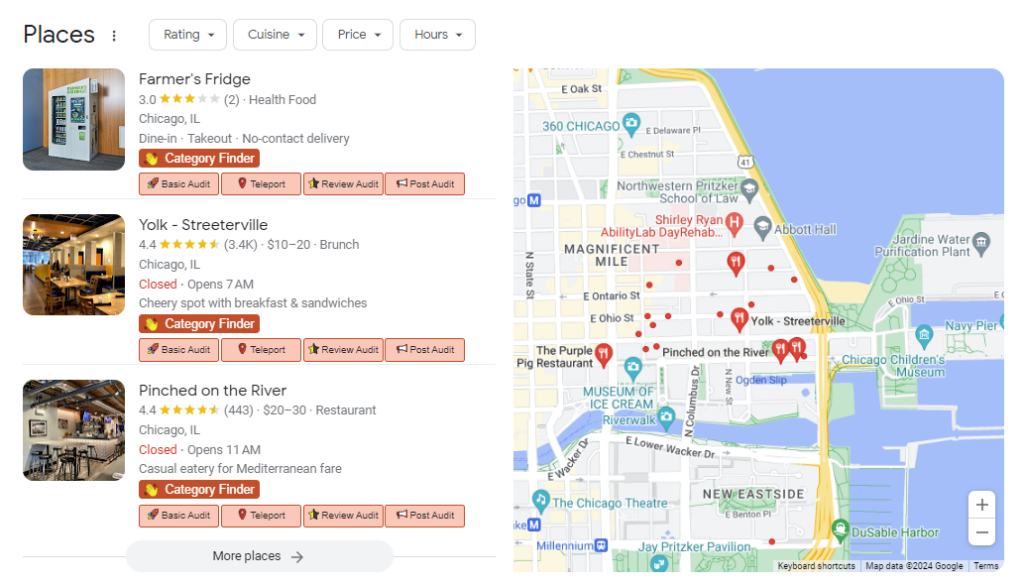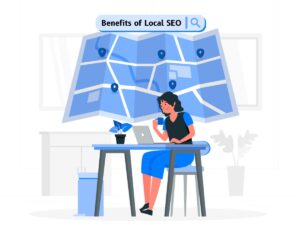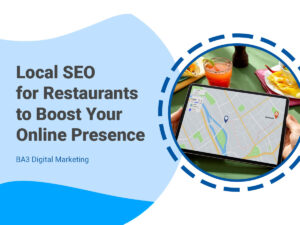Understanding and mastering the concept of local SEO for multiple locations has become crucial for businesses. And the commercial venture operating beyond geographical boundaries can only make it big with multi-local SEO.
Suppose you own a pizza chain scattered across different cities or even countries. How can you reach John in New York and Maria in Barcelona when they punch ‘best pizza near me’ into their search engines?
The answer lies within the realm of local SEO. So, welcome aboard on this walk-through, unraveling the mystery behind multiple-location SEO.

What is Multiple-Location SEO?
Multiple location SEO, also popularly dubbed multi-location SEO, is what the term signifies. Yes, it is optimization targeting several locations – optimizing a business website or online platform to rank well in search engines for numerous physical sites. Thus, your business can reach the customers and audience of a particular area faster than competitors.
This is particularly important for businesses that operate in or serve customers across multiple geographical areas. The goal of multiple location SEO is to ensure when users in specific locations search for relevant products, services, or information; the business appears prominently in the search results for those locations.
If the business is not optimized for specific locations, it may still appear in the search results. However, companies implementing local SEO techniques in their content will occupy the top spot.
In fact, it is a special optimization strategy to signal to search engines that your business is meant for a specific location. This is why Google will let your content appear at the top when searched from and in this geographical location. The result is you reach more potential customers searching for local solutions to their needs.
How to Do Local SEO for Multiple Locations?
As indicated, multiple-location SEO is a digital marketing strategy to optimize your website for numerous geographic locations. Especially if you have physical stores or serve customers in various regions or markets, multiple location SEO practices can give you the most and best returns.
It is important to develop a comprehensive strategy to optimize any website for regions and expand its reach. A common approach is creating landing pages for each local area, ensuring they have unique content and essential contact information (NAP details) And an integral part is optimizing them with relevant keywords using Ahrefs Keywords Explorer.
But prioritizing mobile friendliness is crucial.
Many marketers use Google Mobile-Friendly Test to ensure performance across various devices. Including a location directory that enhances discoverability and helps search engines index the website better is also beneficial.
Incorporating Google Business Profile listings for each location plays a critical role. These listings provide information, visuals, customer reviews and categorizations that improve visibility on map packs and local search results.
Regular website performance monitoring through tools like Google Analytics, Search Console and My Business Insights helps understand rankings and review activities.
Being responsive to customer feedback while continuously striving for improvement ensures that the website remains adaptable and relevant in the market.
Benefits of Multiple-Location SEO
Now, we know what multiple-location SEO is and how to do it for and in various regions or markets. Let’s explain the benefits of multiple-location SEO and how it can help you grow your business. Some of the critical benefits of multiple-location SEO are:
These location-specific SEO strategies help you reach a larger and more relevant audience, both online and offline. By creating location-specific landing pages, you can target your potential customers’ local search intent and preferences in different areas. This can increase your organic traffic, leads, and conversions from local searches.
When you target your brand awareness and authority hike in different locations.
Optimize your Google Business Profile listings and other local citations, and you can see an overwhelming rise in your local visibility and reputation. This effectively ranks higher in the map pack, which is a prominent feature in local search results.
Location-specific SEO boosts your local customer experience and loyalty. You can ensure customer satisfaction and retention by mentioning accurate and consistent information about your business locations, such as name, address, phone number, hours, products, and services. You can also inspire local reviews and links to build trust and credibility with your local audience.
Multiple locations SEO is a strategy that can positively impact your organic traffic, leads, and conversions from local searches. Because, you can target your potential customers’ local search intent and preferences in different areas. This can also help you enhance your brand awareness and authority in different locations and improve your customer experience and loyalty.

10 Steps to Optimize Local SEO for Multiple Locations
Successfully optimizing your business for multiple locations goes beyond simply optimizing your web content with location-based keywords. This local SEO technique involves creating a dedicated webpage or website section for each business location that provides specific, relevant information – from unique store hours to personalized services. Here, you will find a comprehensive guide on optimizing your online business for all locations you target customers to search in and from.
1. Create a Page for Each Location on Your Website
Creating web pages for each of your business locations is a way to enhance local SEO. Having location-specific pages lets you optimize the content with keywords related to each site. This can positively impact your website’s visibility in search engine results when users search.
Think of it as casting a net into the ocean of potential customers, leading to higher engagement from local visitors and increasing the likelihood of conversions. Moreover, these unique pages can also act as landing pages for targeted PPC campaigns based on locations. This helps you connect with promising groups of customers.
2. Optimize Each Page for the Location
This form of SEO goes beyond claiming multiple geographical territories. It requires strategic optimization of each page to cater to its location. This means every aspect, including descriptions, content and images, should reflect a sense of place. Optimizing the content in this way, it acts as a magnet, effectively attracting your target audience seeking localized solutions.
Consider incorporating keywords into your URL structure or meta tags to further enhance your website’s identity. This helps paint a picture of your operating areas. Additionally, use the Google Business Profile to create listings for business locations. By tailoring each page to its location, you increase its visibility for that particular area. Furthermore, it creates an environment that feels familiar and comfortable for customers from the local community.
3. Create Localized Content for Each Location
Crafting content for your business locations is akin to giving each branch its distinct voice on search engines. It’s essential to avoid content that solely replaces the city name. Instead, focus on creating engaging content that resonates with the audience in those areas, forming strong connections with local consumers.
This approach boosts your visibility and fosters trust within different population segments. Think of it as nurturing micro-communities within your customer base. Engage locals by tailoring blogs, infographics, videos or social media posts to reflect habits, conventions and even dialects. Celebrating events or festivals and showing appreciation for community traditions can significantly impact.
Over time, these steps enhance relevance and improve rankings in location-based search queries, ultimately benefiting the local SEO for multiple locations.

4. Optimize Google Business Profile
When optimizing SEO, it’s essential to mention Google Business Profile (GBP) as the tool for locations. Customize this feature for search benefits both customers and businesses alike. For instance, a customer in New York is searching for ‘book shops near me’. By optimizing their GMB profiles, bookshops can ensure they appear in the ‘map pack’, which drives foot traffic to their business.
Expanding this idea across locations may not be as overwhelming. To get started, claim or create listings for all your sites and maintain data across all entries. Customize each profile by adding business descriptions, including images of your site or team members, and even encourage customers to leave reviews after their visit. With an optimized Google Business profile for each location, multi-local SEO becomes a breeze.

5. Gain Positive Reviews
Acquiring reviews goes beyond a ranking factor. It significantly impacts consumer behavior and your brand’s reputation, helping you stand out from competitors in different areas. Positive testimonials serve as proof, guiding potential customers by sharing firsthand experiences of others. Moreover, it gives them insights into the quality of your offerings. Earn these stars by providing service and actively seeking feedback from satisfied clients.

Furthermore, reviews naturally incorporate location-based keywords into user-generated content. For example, a review like “I love the pizza at their Brooklyn location” effortlessly includes keywords for search purposes. Therefore incorporating a review strategy into SEO, for locations can act as your hardworking sales representative operating around the clock.
6. Create Local Business Listings for Each Location
To boost your business presence, it’s crucial to plan, and one effective way to do so is by creating local business listings for each of your locations. This approach can be a game changer for businesses that operate in areas. Platforms like Google, Bing and Yelp offer opportunities to list your business in locations. And that’s what enhances visibility and reach in localized search results.

By listings for each location will you provide the address but establish relevance to potential customers searching in those areas. This can significantly improve your SEO performance. Simply put, more listings mean coverage on the map and a higher chance of being seen by customers. If your business has a footprint, implementing this multi-location local SEO optimization tactic could result in increased web traffic.
7. Build Backlinks for Each Location
Creating a network of backlinks for each of your business locations is like performing a charm on search engine results. It not only enhances your presence but also gives you the advantage of outshining local competitors with finesse. Powerful backlinks work as referrals, boosting credibility and domain authority. This is how you can propel the web pages of each location to the top in location-based searches.
So what’s the secret to success? Collaborate with figures in your community, participate in community outreach programs or contribute valuable content to blogs that cater specifically to your industry. These actions offer opportunities to establish quality localized backlinks.
Keep in mind that search engines appreciate authenticity and local dedication by elevating your position in search rankings. So embark on this fulfilling journey of creating backlinks for every business location. Ultimately being discoverable is crucial, for both online and offline businesses.

8. Schema and Structured Markup
Utilizing Schema and structured markup is an often overlooked, yet highly effective weapon in your SEO arsenal when managing multiple locations. It serves as a digital business card that instructs search engines about the essential details of your website.
They are the type of business you operate, services offered, location specifics and more. By enhancing SERP’s presentation with rich snippets showcasing reviews or descriptions to users pre-click, it immerses potential clients in optimum experiences even before interacting with your site.
9. Demonstrate Credibility
Credibility is not something you are automatically given; it is something you have to earn. This holds true in the realm of SEO optimization for locations. Popular search engines like Google place a value on trustworthiness, and users are more likely to engage with a website that they perceive as credible. Therefore, it is crucial to showcase your credibility not to attract and retain your user base but to significantly improve your website’s ranking.
There are factors involved in establishing this credibility. First and foremost, maintaining NAP (name, address, phone number) information across all platforms is essential. Additionally, having high-quality backlinks from websites helps establish prominence for your site. Providing content that offers value also plays a key role in boosting reliability. Furthermore, encouraging and highlighting positive customer reviews about your services or products further reinforces this trust factor.
10. Avoid Keyword Stuffing
It is crucial to avoid keyword stuffing when optimizing SEO for locations. Search engines like Google don’t appreciate tactics. It may penalize your website by lowering its ranking when you excessively use keywords without providing context. Besides, it disrupts the reading experience and diminishes user satisfaction.
Instead, it’s best to naturally and meaningfully incorporate location-based SEO keywords into your content. Use them in title tags, descriptions and the body of your content where they make sense for the readers. This approach will resonate with both readers and search engine algorithms.

Common Mistakes to Avoid in Multiple Locations SEO
- When creating content for each location page, it’s important to avoid duplicating or using content. Instead, focus on crafting relevant information for each location. Make sure to incorporate keywords and meta tags that align with the search intent and preferences.
- Another crucial aspect is maintaining accurate NAP (name, address and phone number) information across platforms and directories. Take the time to ensure that your business details are correct and up to date on your website Google Business Profile listings, as other local citations.
- Don’t overlook the significance of link building and review generation. Building links from sources within your community can boost your authority and trustworthiness.
Final Thought
To sum up, embracing an SEO strategy for multiple locations is like setting sail to guide your business towards growth and increased profits. If you have businesses in areas, why not capitalize on this advantage to dominate searches and establish a strong online presence? This enables you to target each subsidiary locality effectively attracting customers with tailored content that truly resonates with them.
Integrating location SEO into your digital marketing plan goes beyond mere visibility; it aims to transform every business location into a hub for customer engagement and conversions. The beauty of local SEO for multiple locations lies in its data-driven approach, which provides insights into what works best for each specific area. So, get ready to give your brand the edge it deserves by harnessing the potential of multi-location SEO strategies.
Location is crucial for SEO, especially for businesses with a physical presence. Local SEO helps companies to appear in location-specific searches, improving visibility to nearby customers. Google prioritizes relevant local results, making location a critical factor in search engine rankings.
Yes, server location can impact SEO. A server closer to the target audience reduces website loading times, positively influencing user experience and improving search rankings. However, content delivery networks (CDNs) can mitigate this impact for global audiences.
Local SEO services enhance the online visibility of small businesses in specific geographic areas. This optimization helps attract nearby customers, increases foot traffic, and boosts online conversions. It’s a cost-effective strategy to compete effectively in local markets.
Generally, it’s recommended to have only one domain for the same content. Search engines may view it as duplicate content, and managing multiple domains can be complex. Instead, use subdomains or subdirectories to organize content without diluting SEO efforts.
Location-based keywords are terms that include specific geographic references. Examples include “best coffee shop in [City],” “plumber near me,” or “affordable hotels in [Region].” Incorporating these keywords into content helps businesses rank higher in local search results and attract relevant local audiences.









